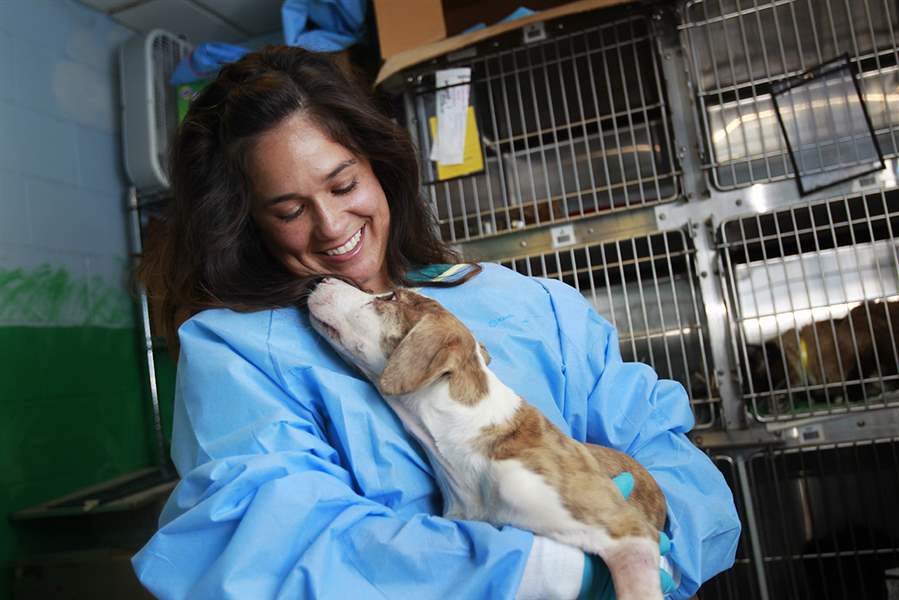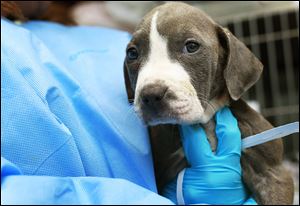
Lucas County shelter sees influx of puppies with parvo
7/19/2014
Missy, a 3-month-old female brindle-white ‘pit bull’ mix with canine parvovirus, is held by technician Jen Martinez.
THE BLADE/ISAAC HALE
Buy This Image

Missy, a 3-month-old female brindle-white ‘pit bull’ mix with canine parvovirus, is held by technician Jen Martinez.
Dogs in Lucas County could be in for a difficult summer if a possible surge in canine parvovirus becomes a trend.
Julie Lyle, director of Lucas County Canine Care & Control, said she sees parvovirus year-round, though it is generally more prevalent in the summer months when the weather is warm and people are out with their dogs more often. In the last few weeks, the shelter has seen a sudden influx of puppies that have contracted the highly contagious and often fatal illness.
“Parvo is in the environment everywhere,” she said. “We’re definitely above average right now.”
Dr. Michael Washkevich, a veterinarian at the Animal Emergency & Critical Care Center on Douglas Road in Toledo, said parvo is a very hardy virus that can survive on surfaces for months and is difficult to kill. It is spread through feces.
Parvovirus attacks the bone marrow, suppressing the immune system, and affects rapidly reproducing cells such as those in the gastrointestinal tract. As the disease progresses, the lining in a dog’s GI tract will slough off, allowing bacteria to leak through into the abdomen.
“It’s just a nasty, nasty disease,” Dr. Washkevich said. “It’s very painful and there’s no cure. All you can do is provide supportive care to help them fight it. Even with hospitalization, some don’t make it.”
Nearly all cases are in puppies because of their weaker immune systems and because they are often too young to be fully vaccinated against it. Dr. Washkevich said unvaccinated adult animals can contract parvo, but that scenario is far less likely.
Ms. Lyle said the county will transfer puppies with parvo as quickly as possible to the Toledo Area Humane Society if space is available there. The humane society is currently treating four parvo-positive puppies from Lucas County and has several others that were treated previously and have recovered.
Executive Director Gary Willoughby said caring for dogs with parvo stresses shelters. It’s not only expensive to treat, but a quarantine area can house only dogs with parvovirus and not those with other ailments, such as kennel cough. Shelters must limit which staff can care for the puppies, and those individuals must be very careful not to carry the virus out of the isolation area on their clothing.

Petunia, a 2-month-old female blue and white ‘pit bull’ mix with canine parvovirus, is recovering.
The same time of year that parvo cases increase is also generally known as “kitten season,” when shelters experience an influx of cats and kittens. Fortunately, cats can be isolated in the same area as parvo puppies because felines cannot contract the virus.
“You still only have so much space available,” Mr. Willoughby said. “We’re finding every inch of space we possibly can.”
If a parvo-positive dog is gravely ill or if the county shelter cannot find a transfer, it is killed. As of Wednesday, 10 such puppies had been killed this month. Ms. Lyle said the facility has neither the space to properly quarantine them nor the staff and resources to give them the intensive care they need.
“We have the responsibility to the public’s dogs that are in and out every day to keep them safe,” Ms. Lyle said. “We can’t put them at risk by housing parvo dogs here.”
Adding to the risk, most of the dogs in the shelter have unknown or nonexistent vaccination histories.
“Do you try to treat a parvo puppy and risk possibly exposing 150 other dogs in the shelter, some of which are owned? Or do you humanely euthanize the puppy?” Ms. Lyle said. “You have to make that decision.”
Dr. Washkevich said the emergency veterinary office has seen an “incredible amount” of parvo cases lately. He said the office normally sees three to five cases a week. He estimated that the clinic recently has sometimes seen that many in a single day.

“It’s been consistent throughout the last couple of weeks,” he said. “It’s dramatically increased.”
Mr. Willoughby said the open-admissions humane society has seen five parvo puppies surrendered to it over the last month or so in addition to those it has taken from the Lucas County shelter.
Shelters in all of the counties surrounding Lucas County reported they have not seen any unusual increase in parvovirus. Likewise, some of the state’s more urban shelters in Franklin, Cuyahoga, and Montgomery counties said they have not noticed any unusual spikes in parvo cases, nor has the Ohio Veterinary Medical Association heard of any significant outbreak anywhere across the state.
Dr. Washkevich said there’s no way to know what may or may not be happening in Lucas County. What seems like a rising number of parvovirus cases could just be a fluke.
But people should still be aware and cautious, he said. Dog owners, particularly those with puppies, should be careful about what dogs and environments their pets are exposed to. Above all, they should get their dogs properly vaccinated as soon as possible.
“No vaccination ensures 100 percent immunity, but it goes a long way,” Dr. Washkevich said.
Contact Alexandra Mester: amester@theblade.com, 419-724-6066, or on Twitter @AlexMesterBlade.